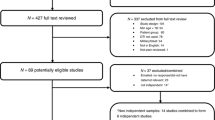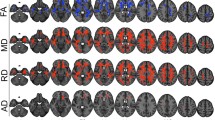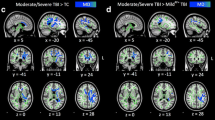Abstract
Traumatic brain injury (TBI) frequently results in impairments of memory, speed of information processing, and executive functions that may persist over many years. Diffuse axonal injury is one of the key pathologies following TBI, causing cognitive impairments due to the disruption of cortical white matter pathways. The current study examined the association between injury severity, cognition, and fractional anisotropy (FA) following TBI. Two diffusion tensor imaging techniques—region-of-interest tractography and tract-based spatial statistics—were used to assess the FA of white matter tracts. This study examined the comparability of these two approaches as they relate to injury severity and cognitive performance. Sixty-eight participants with mild-to-severe TBI, and 25 healthy controls, underwent diffusion tensor imaging analysis. A subsample of 36 individuals with TBI also completed cognitive assessment. Results showed reduction in FA values for those with moderate and severe TBI, compared to controls and individuals with mild TBI. Although FA tended to be lower for individuals with mild TBI no significant differences were found compared to controls. Information processing speed and executive abilities were most strongly associated with the FA of white matter tracts. The results highlight similarities and differences between region-of-interest tractography and tract-based spatial statistics approaches, and suggest that they may be used together to explore pathology following TBI.





Similar content being viewed by others
References
Aggleton JP (2008) Understanding anterograde amnesia: disconnections and hidden lesions. Q J Exp Psychol 61:1441–1471
Aggleton JP, Brown MW (1999) Episodic memory, amnesia and the hippocampal-anterior thalamic axis. Behav Brain Sci 22:425–444
Arfanakis K, Haughton VM, Carew JD, Rogers BP, Dempsey RJ, Meyerand ME (2002) Diffusion tensor mr imaging in diffuse axonal injury. Am J Neuroradiol 23:794–802
Ashburner J, Friston KJ (2000) Voxel-based morphometry—the methods. Neuroimage 11:805–821
Baddeley A, Emslie H, Nimmo-Smith I (1994) Doors and people. Thames Valley Test Company, Bury St Edmunds
Basser PJ (1995) Inferring microstructural features and the physiological state of tissues from diffusion-weighted images. NMR Biomed 8:333–344
Basser PJ, Mattiello J, Lebihan D (1994) Mr diffusion tensor spectroscopy and imaging. Biophys J 66:259–267
Behrens TEJ, Johansen-Berg H, Woolrich MW, Smith SM, Wheeler-Kingshott CAM, Boulby PA et al (2003) Non-invasive mapping of connections between human thalamus and cortex using diffusion imaging. Nat Neurosci 6:750–757
Benson RR, Meda SA, Vasudevan S, Kou ZF, Govindarajan KA, Hanks RA et al (2007) Global white matter analysis of diffusion tensor images is predictive of injury severity in traumatic brain injury. J Neurotrauma 24:446–459
Benton AL, Hamsher K, Rey GJ (1994) Multilingual aphasia examination, 3rd edn. AJA Associates, Iowa Cita
Bigler ED (2001) The lesion(s) in traumatic brain injury: implications for clinical neuropsychology. Arch Clin Neuropsychol 16:95–131
Bigler ED, McCauley SR, Wu TC, Yallampalli R, Shah S, MacLeod M et al (2010) The temporal stem in traumatic brain injury: preliminary findings. Brain Imaging Behav 4:270–282
Bookstein FL (2001) “Voxel-based morphometry” should not be used with imperfectly registered images. Neuroimage 14:1454–1462
Bucur B, Madden DJ, Spaniol J, Provenzale JM, Cabeza R, White LE et al (2008) Age-related slowing of memory retrieval: contributions of perceptual speed and cerebral white matter integrity. Neurobiol Aging 29:1070–1079
Buki A, Povlishock JT (2006) All roads lead to disconnection? Traumatic axonal injury revisited. Acta Neurochir 148:181–193
Burgess PW, Shallice T (1997) The Hayling and Brixton tests. Thames Valley Test Company, Bury St Edmunds
Coughhlan AK, Oddy M, Crawford JR (2007) Birt memory and information processing battery London. Brain injury rehabilitation trust, Wakefield
Davatzikos C (2004) Why voxel-based morphometric analysis should be used with great caution when characterizing group differences. Neuroimage 23:17–20
Dikmen SS, Machamer JE, Winn HR, Temkin NR (1995) Neuropsychological outcome at 1-year post head injury. Neuropsychology 9:80–90
Draper K, Ponsford J (2008) Cognitive functioning ten years following traumatic brain injury and rehabilitation. Neuropsychology 22:618–625
Fling BW, Chapekis M, Reuter-Lorenz PA, Anguera J, Bo J, Langan J et al (2011) Age differences in callosal contributions to cognitive processes. Neuropsychologia 49:2564–2569
Foxe JJ, Simpson GV (2002) Flow of activation from v1 to frontal cortex in humans: a framework for defining “early” visual processing. Exp Brain Res 142:139–150
Geary EK, Kraus MF, Pliskin NH, Little DM (2010) Verbal learning differences in chronic mild traumatic brain injury. J Int Neuropsychol Soc 16:506–516
Gennarelli TA, Thibault LE, Graham DI (1998) Diffuse axonal injury: an important form of traumatic brain damage. Neuroscientist 4:202–215
Huisman TAGM, Sorensen AG, Hergan K, Gonzalez RG, Schaefer PW (2003) Diffusion-weighted imaging for the evaluation of diffuse axonal injury in closed head injury. J Comput Assist Tomogr 27:5–11
Jiang H, van Zijl PCM, Kim J, Pearlson GD, Mori S (2006) Dtistudio: resource program for diffusion tensor computation and fiber bundle tracking. Comput Methods Programs Biomed 81:106–116
Johansen-Berg H, Behrens TEJ, Sillery E, Ciccarelli O, Thompson AJ, Smith SM et al (2005) Functional–anatomical validation and individual variation of diffusion tractography-based segmentation of the human thalamus. Cereb Cortex 15:31–39
Jones DK, Griffin LD, Alexander DC, Catani M, Horsfield MA, Howard R et al (2002) Spatial normalization and averaging of diffusion tensor MRI data sets. Neuroimage 17:592–617
Jones DK, Symms MR, Cercignani M, Howard RJ (2005) The effect of filter size on VBM analyses of DT-MRI data. Neuroimage 26:546–554
Kennedy MR, Wozniak JR, Muetzel RL, Mueller BA, Chiou HH, Pantekoek K et al (2009) White matter and neurocognitive changes in adults with chronic traumatic brain injury. J Int Neuropsychol Soc 15:130–136
Kinnunen KM, Greenwood R, Powell JH, Leech R, Hawkins PC, Bonnelle V et al (2011) White matter damage and cognitive impairment after traumatic brain injury. Brain 134:449–463
Konrad A, Vucurevic G, Musso F, Stoeter P, Winterer G (2009) Correlation of brain white matter diffusion anisotropy and mean diffusivity with reaction time in an oddball task. Neuropsychobiology 60:55–66
Kraus MF, Susmaras T, Caughlin BP, Walker CJ, Sweeney JA, Little DM (2007) White matter integrity and cognition in chronic traumatic brain injury: a diffusion tensor imaging study. Brain 130:2508–2519
Kumar R, Husain M, Gupta RK, Hasan KM, Haris M, Agarwal AK et al (2009) Serial changes in the white matter diffusion tensor imaging metrics in moderate traumatic brain injury and correlation with neuro-cognitive function. J Neurotrauma 26:481–495
Levin HS (2003) Neuroplasticity following non-penetrating traumatic brain injury. Brain Inj 17:665–674
Levin HS, Wilde E, Troyanskaya M, Petersen NJ, Scheibel R, Newsome M et al (2010) Diffusion tensor imaging of mild to moderate blast-related traumatic brain injury and its sequelae. J Neurotrauma 27:683–694
Lipton ML, Gellella E, Lo C, Gold T, Ardekani BA, Shifteh K et al (2008) Multifocal white matter ultrastructural abnormalities in mild traumatic brain injury with cognitive disability: a voxel-wise analysis of diffusion tensor imaging. J Neurotrauma 25:1335–1342
Little DM, Kraus MF, Joseph J, Geary EK, Susmaras T, Zhou XJ et al (2010) Thalamic integrity underlies executive dysfunction in traumatic brain injury. Neurology 74:558–564
Lo C, Shifteh K, Gold T, Bello JA, Lipton ML (2009) Diffusion tensor imaging abnormalities in patients with mild traumatic brain injury and neurocognitive impairment. J Comput Assist Tomogr 33:293–297
Mayer AR, Ling J, Mannell MV, Gasparovic C, Phillips JP, Doezema D et al (2010) A prospective diffusion tensor imaging study in mild traumatic brain injury. Neurology 74:643–650
Messé A, Caplain S, Paradot G, Garrigue D, Mineo J-F, Ares GS et al (2011) Diffusion tensor imaging and white matter lesions at the subacute stage in mild traumatic brain injury with persistent neurobehavioral impairment. Hum Brain Mapp 32:999–1011
Metzler-Baddeley C, Jones DK, Belaroussi B, Aggleton JP, O’Sullivan MJ (2011) Frontotemporal connections in episodic memory and aging: a diffusion MRI tractography study. J Neurosci 31:13236–13245
Miles L, Grossman RI, Johnson G, Babb JS, Diller L, Inglese M (2008) Short-term DTI predictors of cognitive dysfunction in mild traumatic brain injury. Brain Inj 22:115–122
Mori S, van Zijl PCM (2002) Fiber tracking: principles and strategies: a technical review. NMR Biomed 15:468–480
Mori S, Wakana S, Van Zijl PCM (2005) MRI atlas of human white matter. Elsevier, Amsterdam
Nakayama N, Okumura A, Shinoda J, Yasokawa YT, Miwa K, Yoshimura SI et al (2006) Evidence for white matter disruption in traumatic brain injury without macroscopic lesions. J Neurol Neurosurg Psychiatry 77:6
Newcombe VFJ, Williams GB, Nortje J, Bradley PG, Harding SG, Smielewski P et al (2007) Analysis of acute traumatic axonal injury using diffusion tensor imaging. Br J Neurosurg 21:340–348
Niogi SN, Mukherjee P, Ghajar J, Johnson C, Kolster RA, Sarkar R et al (2008a) Extent of microstructural white matter injury in postconcussive syndrome correlates with impaired cognitive reaction time: a 3t diffusion tensor imaging study of mild traumatic brain injury. Am J Neuroradiol 29:967–973
Niogi SN, Mukherjee P, Ghajar J, Johnson CE, Kolster R, Lee H et al (2008b) Structural dissociation of attentional control and memory in adults with and without mild traumatic brain injury. Brain 131:3209–3221
Park H-J, Kubicki M, Shenton ME, Guimond A, McCarley RW, Maier SE et al (2003) Spatial normalization of diffusion tensor MRI using multiple channels. Neuroimage 20:1995–2009
Ponsford J, Olver JH, Curran C (1995a) A profile of outcome: 2 years after traumatic brain injury. Brain Inj 9:1–10
Ponsford J, Olver JH, Ng K (1995b) Prediction of employment status 2 years after traumatic brain injury. Brain Inj 9:11–20
Povlishock JT, Christman CW (1994) The pathobiology of traumatically induced axonal injury in animals and humans: a review of current thoughts. US Government Printing Office, Washington, Dc
Povlishock JT, Jenkins LW (1995) Are the pathobiological changes evoked by traumatic brain injury immediate and irreversible? Brain Pathol 5:415–426
Povlishock JT, Katz DI (2005) Update of neuropathology and neurological recovery after traumatic brain injury. J Head Trauma Rehabil 20:76–94
Reitan RM, Wolfson D (1988) The Halstead–Reitan neuropsychological test battery. Neuropsychology Press, Tucson
Rugg-Gunn FJ, Symms MR, Barker GJ, Greenwood R, Duncan JS (2001) Diffusion imaging shows abnormalities after blunt head trauma when conventional magnetic resonance imaging normal. J Neurol Neurosurg Psychiatry 70:530–533
Salmond CH, Menon DK, Chatfield DA, Williams GB, Pena A, Sahakian BJ et al (2006) Diffusion tensor imaging in chronic head injury survivors: correlations with learning and memory indices. Neuroimage 29:117–124
Scheid R, Preul C, Gruber O, Wiggins C, von Cramon DY (2003) Diffuse axonal injury associated with chronic traumatic brain injury: evidence from t2*-weighted gradient-echo imaging at 3 t. Am J Neuroradiol 24:1049–1056
Schretlen DJ, Shapiro AM (2003) A quantitative review of the effects of traumatic brain injury on cognitive functioning. Int Rev Psych 15:341–349
Shenton ME, Hamoda HM, Schneiderman JS, Bouix S, Paternak O, Rathi Y et al (2012) A review of magnetic resonance imaging and diffusion tensor imaging findings in mild traumatic brain injury. Brain Imaging Behav 6:137–192
Sidaros A, Engberg AW, Sidaros K, Liptrot MG, Herning M, Petersen P et al (2008) Diffusion tensor imaging during recovery from severe traumatic brain injury and relation to clinical outcome: a longitudinal study. Brain 131:559–572
Smith A (1973) Symbol digit modalities test. Western Psychological Services, Los Angeles
Smith SM, Nichols TE (2009) Threshold-free cluster enhancement: addressing problems of smoothing, threshold dependence and localisation in cluster inference. Neuroimage 44:83–98
Smith SM, Jenkinson M, Woolrich MW, Beckmann CF, Behrens TEJ, Johansen-Berg H et al (2004) Advances in functional and structural mr image analysis and implementation as fsl. Neuroimage 23:S208–S219
Smith SM, Jenkinson M, Johansen-Berg H, Rueckert D, Nichols TE, Mackay CE et al (2006) Tract-based spatial statistics: voxelwise analysis of multi-subject diffusion data. Neuroimage 31:1487–1505
Smith SM, Johansen-Berg H, Jenkinson M, Rueckert D, Nichols TE, Miller KL et al (2007) Acquisition and voxelwise analysis of multi-subject diffusion data with tract-based spatial statistics. Nat Protoc 2:499–503
Sugiyama K, Kondo T, Oouchida Y, Suzukamo Y, Higano S, Endo M et al (2009) Clinical utility of diffusion tensor imaging for evaluating patients with diffuse axonal injury and cognitive disorders in the chronic stage. J Neurotrauma 26:1879–1890
Toth A, Kovacs N, Perlaki G, Orsi G, Aradi M, Komaromy H et al (2013) Multi-modal magnetic resonance imaging in the acute and sub-acute phase of mild traumatic brain injury: can we see the difference? J Neurotrauma 30:2–10
Turken U, Whitfield-Gabrieli S, Bammer R, Baldo JV, Dronkers NF et al (2008) Cognitive processing speed and the structure of white matter pathways: convergent evidence from normal variation and lesion studies. Neuroimage 42:1032–1044
Wechsler D (1997) Wechsler memory scale, 3rd edn. The Psychological Corporation, San Antonio
Wechsler D (2008) Wechsler adult intelligence scale, 4th edn. Pearson, San Antonio
Xu J, Rasmussen IA, Lagopoulos J, Haberg A (2007) Diffuse axonal injury in severe traumatic brain injury visualized using high-resolution diffusion tensor imaging. J Neurotrauma 24:753–765
Acknowledgments
We thank all the staff of Healthcare Imaging MRI facility at the Epworth Hospital, Melbourne, Victoria.
Conflict of interest
The authors declare that they have no competing financial interests.
Author information
Authors and Affiliations
Corresponding author
Rights and permissions
About this article
Cite this article
Spitz, G., Maller, J.J., O’Sullivan, R. et al. White Matter Integrity Following Traumatic Brain Injury: The Association with Severity of Injury and Cognitive Functioning. Brain Topogr 26, 648–660 (2013). https://doi.org/10.1007/s10548-013-0283-0
Received:
Accepted:
Published:
Issue Date:
DOI: https://doi.org/10.1007/s10548-013-0283-0




